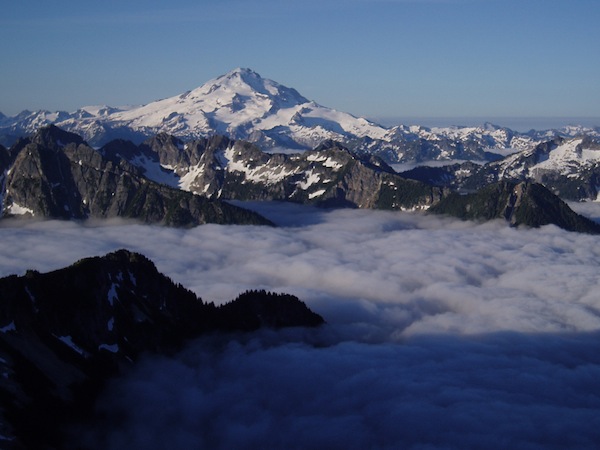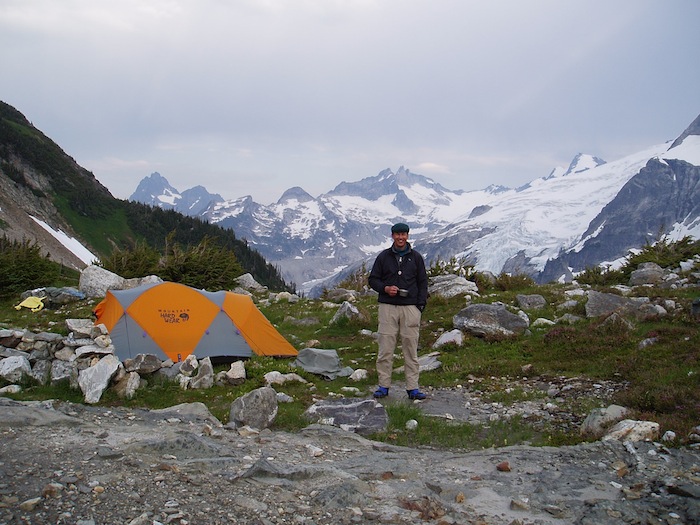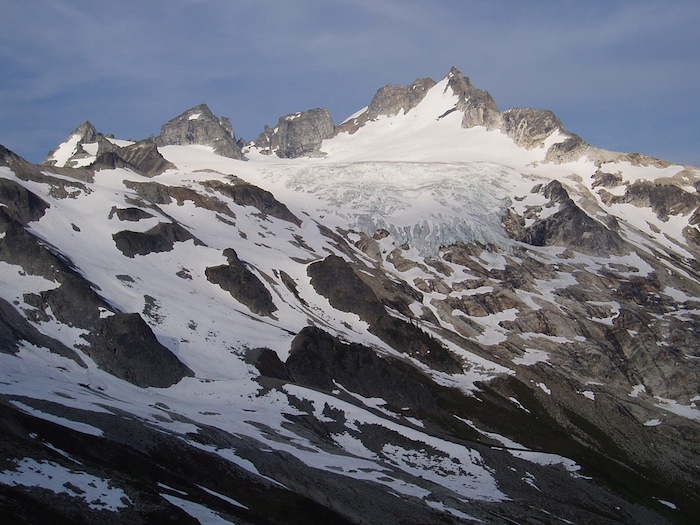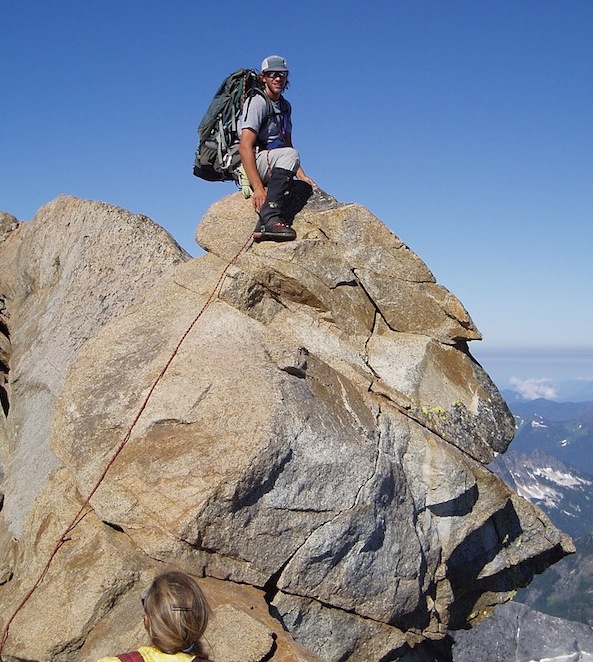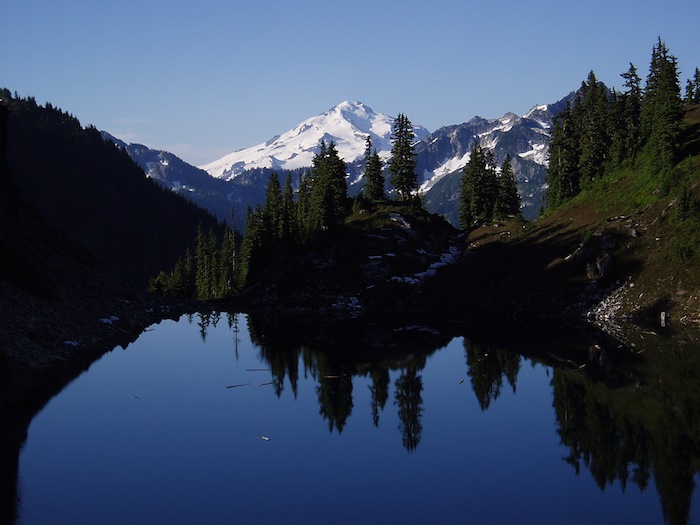The Ptarmigan Traverse - Technical Backpacking and Climbing
Itinerary
Alert!: Partial Closure of Traverse
Please be aware that the full Ptarmigan Traverse is not currently available. The southern terminus of the trail is closed due to past fire damage, wash-outs, and potential for severe mudslides. The US Forest Service has not issued a planned reopening date yet, but will go in to evaluate the condition of the trail and the surrounding terrain once the winter snows have melted and the trail is accessible.
That being said, we can still do the first portion of the Traverse as an "out-and-back" that starts from the north side.
Standard Itinerary
The Ptarmigan Traverse can be done as a four-day ski program, a five-day mountaineering program without any summits, or as a seven-day program with a couple of different climbing objectives on the route.
The following itinerary was designed for the seven-day group program.
Day One: Cascade Pass Trailhead (3,600') to Kool Aid Lake (6,120') 6-8 Hours
On the first day of the program we will meet at 7am at the American Alpine Institute for a morning gear check. Once everything is complete, we will make our way to the trailhead approximately two hours from Bellingham.
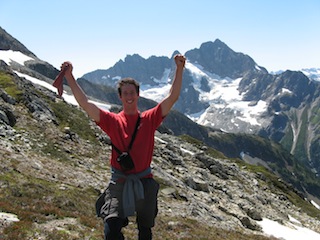
The top of Cascade Pass with Johannesburg Mountain in the Background. John Scripps
The Cascade Pass trailhead can be found at 3,600' at the end of the Cascade River Road. From there we will hike 3.7 miles on the well maintained Cascade Pass trail up through 36 switchbacks to Cascade Pass at 5,400'. (Approximately 2 hours)
At Cascade Pass, turn we will turn right 90 degrees, and head south up the Mix-up Arm on a well worn trail through the heather and talus. We will follow this trail to a rocky spur at 6,100' and then drop onto the Cache glacier. We'll then make our way up to Cache Col passing two side-by-side notches (Gunsight notch) on the right in Mix-up Peak's SW ridge.
At Cache Col, there are campsites, but there is limited water and shelter from the wind. If we decided to climb Mix-Up Peak, we might stay here.
Day Two: Kool Aid Lake to Yang Yang Lakes (5,830') 8-11 Hours
The descent from here down to Kool Aid Lake at 6,120', is a quick 1-2 hours. We'll follow the trail down through the heather and talus, crossing several small snowfields to Kool Aid Lake and good camping.
From Kool Aid Lake, we'll head south on either a trail or on intermittent snow fields to the Red Ledges which are the big red scar in the black rock spur below Art's Knoll. We'll traverse to the ledges and climb a small snow finger just left of and below the ledges. The ledges themselves are broad and easy, unless covered with snow. We'll continue to follow these right until the exit onto the meadows of Art's Knoll are reached.
From here we'll descend the trail around a spur, under a series of small bluffs. From here it is possible to see two cols at the top of the Middle Cascade Glacier, the proper col is the one to the east/left. We'll cross a series of gravel ribs and small snowfields until cresting on a rounded rock hump just North of the Middle Cascade Glacier.
From there, we'll enter the glacier above the prominent icefall (6,400') and travel up the Middle Cascade Glacier, staying left of center. At the top (7,400'), we'll traverse left to the second col.
It is possible to see Yang yang Lakes from the Spider/Formidable col (7,320') so we'll inspect the route carefully for tracks and/or debris before heading down, as this is the best view.
From there, we'll descend moderately steep snow (up to 40+ degrees) for 200', and then take a hard right below the rocky point on the right. We'll traverse across snow covered granite benches passing beneath Mount Formidable. From the lower east side of the snowfield, it is possible to pick-up the trail leading to the lakes and good campsites on the Southeastern shore of the lakes.
Day Three: Yang Yang Lakes (5,830') to White Rock Lakes (6,200') 7-11 Hours
The start of the trek for the day is not obvious. As such, we'll scramble southwest from the southernmost lake along worn tracks starting on the west shore, aiming toward the left (south) corner of a horizontal snowfield at perhaps 6,200'. From there a distinct but steep track works its way up through rocks and heather, reaching LeConte Pass at approximately 6,200'. We'll Contour southwest along heather, scree and snowfield until arriving underneath the east flank of LeConte Mountain.
If time and conditions permit, we will make a quick ascent of LeConte Mountain's Northwest Ridge, a 3rd and 4th class scramble with some steep snow.
From the base of the mountain we will drop down and skirt below a black buttress between the route and the LeConte Glacier. Once on the glacier climb we'll climb fairly easy snowslopes, staying right of center, weaving through a few medium sized crevasses to the Sentinel-LeConte saddle (7,800').
Beyond the saddle, we'll gently descend the west flank of Sentinel, maintaining a high but gently descending contour across the snow covered bench and several talus ribs until reaching a gentle snow slow that leads south down to the head of the South Cascade Glacier (6,800') and walk across the very gentle glacier to Lizard Pass (6,600').
At Lizard Pass there are two choices. We'll either descend to a rock spur just left of the snow slope and find a steep, exposed trail following it down to the lakes. Or we'll head down the moderately steep snow slope (35 degrees) until it ends. We''ll then traverse from the bottom left corner of the slope and find the rock spur trail. We'll continue to follow this down through the steep slabs below. Campsites are located on the south shore of the lake.
Day Four: Ascent of Sentinal Peak and Old Guard Peak
Day four has been set aside as a summit day. However, those who wish to take a day off to enjoy the mountains instead of climbing would be welcome to do so.
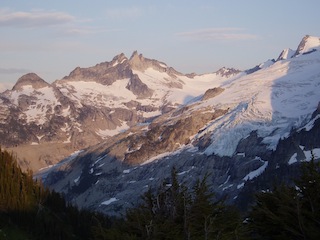
Sinister Peak from White Rock Lakes Myron Allen
From White Rock Lakes we will work our way back to the LeConte glacier where we will make an ascent of the Southwest ridge of Sentinal Peak. This line requires some low to mid-fifth class climbing with a little bit of steep snow.
We will then descend to the LeConte Glacier where we will make a second ascent. This will be of the east ridge of Old Guard Peak. Two pitches of mid-fifth class climbing will bring us to a classic summit in the heart of the Cascade Range.
On the fourth day of the program, we will have our vehicle moved to the other end of the traverse by AAI shop employees.
Day Five: White Rock Lakes (6,200') to Itswoot Ridge (6,400)/Cub Lake (5,340') 8-12 Hours
From White Rock Lakes, we'll follow a trail heading right/southwest from White Rock Lake, which stays on top of the bench. As the trail wraps around to the head of the West Fork of Agnes Creek valley, it descends through the cliff bands to approximately 5,800'. We'll cross several snowfields and talus ribs until a low angle snow and scree gully is discovered which leads back up to the Dana Glacier's far right snowfields.
Once on the Dana Glacier, we'll ascend southeast to the most difficult col to find in the entire trip. We'll poke around on the ridge until we find the col at approximately 7,600' that requires about 30' of third class scrambling which leads to the far western edge of the Dome Glacier and Cub Lake.
From the col, we'll descend a trail to the snow-fields below and traverse west across three gullies. The right side of gully number three is Itswoot Ridge. It is possible to glissade down the gully until it flattens out. Then we'll follow it down favoring the west side of the ridge with Spire Creek to the right/west.
At 6,400' there are a number of campsites which would make excellent staging areas for an attempt on Dome Peak. Or it is possible to continue for another hour on the trail to Cub Lake.
Day Six: Ascent of Dome Peak
The sixth day has been set aside for another ascent. Most parties will climb Dome Peak, but Sinister and Gunsight Peaks are also options. If a party wants to focus on climbing in this excellent area, they may elect not to take Day Four off for climbing and to focus their climbing efforts here.
The Dome Glacier Route is the most popular line on Dome, with thirty-five degree glacier travel and a few third class moves, but there are some other harder options on the South Face of the summit pyramid if there is interest in rock climbing.
Day Seven: Itswoot Ridge/Cub Lake to Downy Creek Trailhead (1,450') 7-12 Hours
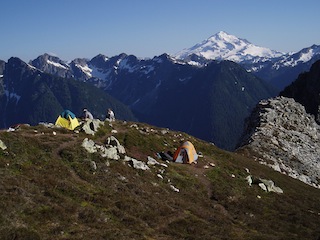
A Scenic Camp on Itswoot Ridge Myron Allen
From the ridge camp, we'll follow the trail south toward Itswoot Lake. We'll take the trail around the north shore of the lake then up over the saddle at 6,000' between the lake and Bachelor Creek (2-3 hours). Trail work was recently done, making the last 14+ miles relatively pleasant compared to years past. We'll follow the trail down paralleling the south side of Bachelor Creek. We'll cross Bachelor creek at 3,750' via a log/rock hop and continue down the trail until we reach Downey Creek and the Six Mile camp at 2,420' in 3-5 hours.
There are three ways to cross Bachelor Creek. We'll either cross a high log (10' above the creek); wade across in mid-thigh water.; or walk across a small log dam 40' above Downey Creek.
Once we are across the creek it is easy walking on 6.6 miles of maintained trail. (3 - 5 hours).
The Ptarmigan Traverse - Technical Backpacking and Climbing
Skiing the Traverse
Over the last few years the Ptarmigan Traverse has become a popular ski objective. This makes sense as most of the route lives in the "blue run" world, with a few spots sporting single "black diamond runs." Backcountry skiers who are comfortable on 35-degree terrain in variable conditions with a multi-day pack on should be capable of competently completing this traverse.
The number of days required for the traverse will be determined by the amount of snow coverage. The south end of the traverse currently requires a fair bit of bushwacking and road walking. If this is snow-covered, some of the tree-skiing could be difficult, but movement on open trails and old roads would be quite fast.
Some parties elect to do a Ptramigan Tour as opposed to the complete traverse. In other words, they ski from the north end out to the south end of the traverse and back. This option still allows skiers to see the whole of the traverse, but also allows them to avoid the unpleasant descent described on day seven of the itinerary.
Other parties choose to descend back to the Cascade River Road via the South Cascade Glacier. Depending on snowcoverage and avalanche conditions, this can provide an alternative to retracing ones steps back to the end of Cascade River Road or to descending into Downey Creek.
Ptarmigan Ski Season
The season for skiing the Ptarmigan Traverse is usually April through June, though some years it is possible to ski the bulk of the traverse well into July.
Pricing for Skiers
The Ptarmigan Traverse is offered as a private ski program that runs from four to seven days in length. The length of the trip is determined by the number of peaks that you wish to climb and ski while traversing the route.
Pricing for private ski programs are as follows:
-
- 1 participant to 1 guide: $675 per day
- 2 participants to 1 guide: $485 per person per day
- 3 participants to 1 guide: $360 per person per day
- 4 participants to 1 guide: $325 per person per day
Inclusions: Guide, group climbing gear, and backcountry permit fees.
Exclusions: Travel and lodging before and after the trip, personal climbing, skiing and camping gear, food, and guide gratuities. Additionally, if you choose to do the complete traverse and not just the tour, there will need to be transportation available on both ends.
Please note that setting up transportation (car shuttles) before and after a private trip may take up to half-a-day.
